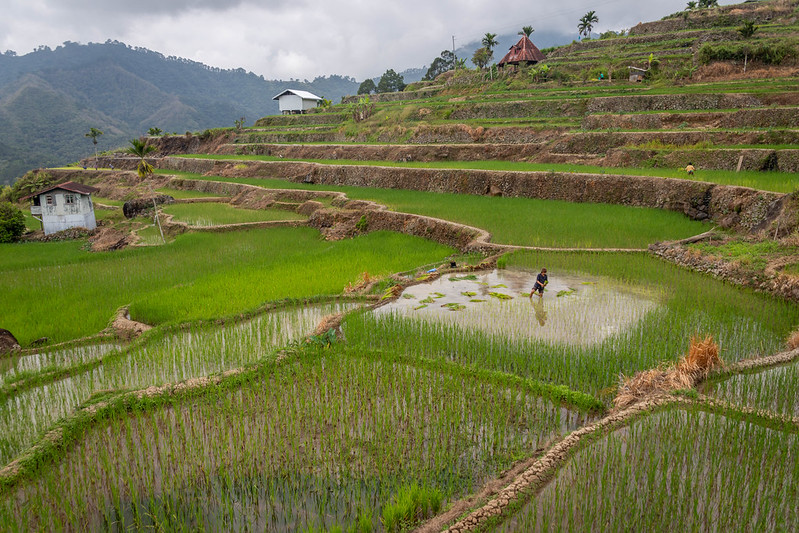Mayoyao Rice Terraces: A UNESCO World Heritage Site in the Philippines
11 min read
Mayoyao Rice Terraces in Ifugao, Philippines
If you’re looking for a breathtaking natural wonder to visit in the province of Ifugao, the Mayoyao Rice Terraces should definitely be on your list. Located in the Ifugao province in the Cordillera Region of Luzon, these rice terraces are one of the five clusters that make up the UNESCO World Heritage inscription Rice Terraces of the Philippine Cordilleras.
The Mayoyao Rice Terraces are a testament to the ingenuity and hard work of the indigenous Ifugao people, who built them over 2,000 years ago using simple hand tools and without the use of any machinery. The terraces are built into the steep slopes of the Cordillera Mountains and are irrigated by a complex system of canals and aqueducts that bring water from the forests above. The result is a stunning landscape of rice paddies that cascade down the mountainside in a series of steps, creating a unique and beautiful sight that has been compared to a giant staircase.
Visiting the Mayoyao Rice Terraces is not just a chance to see a natural wonder but also an opportunity to learn about the culture and history of the Ifugao people. The terraces are still in use today, and visitors can see the traditional farming methods that have been passed down through generations. The people of Mayoyao are also known for their hospitality and friendliness, making a visit to the terraces not just a sightseeing trip but a chance to connect with the local community.
Location of Mayoyao Rice Terraces
The terraces are located in the municipality of Mayoyao, in the Ifugao Province of the Cordillera Administrative Region. Mayoyao is situated in the eastern part of the province, about 50 kilometers from Banaue town proper.
Getting to Mayoyao can be quite challenging, as the town is very remote and the terrain is rugged. You’ll need to endure a grueling four-hour motor ride on dirt tracks to reach the rice terraces. However, the journey is worth it once you see the breathtaking views of the terraces.
The Mayoyao Rice Terraces is one of the five clusters of rice terraces that make up the Rice Terraces of the Philippine Cordilleras, a UNESCO World Heritage Site. The other four clusters are the Batad Rice Terraces and Bangaan Rice Terraces in Banaue, the Hungduan Rice Terraces in Hungduan, and the Nagacadan Rice Terraces in Kiangan.
The Mayoyao Rice Terraces cover a total area of 10,360 hectares and are composed of 25 clusters. Each cluster has its own distinct features and characteristics. The terraces are carved into the mountainside and are irrigated by a complex system of canals and channels that bring water from the nearby forests and streams.
In conclusion, the Mayoyao Rice Terraces is a hidden gem that is definitely worth the journey. The remote location and rugged terrain only add to the charm and beauty of the terraces. If you’re looking for a unique and unforgettable experience, make sure to add the Mayoyao Rice Terraces to your travel itinerary.

Historical Significance
Mayoyao Rice Terraces is a UNESCO World Heritage site located in the Ifugao Province of the Philippines. The site is a living cultural landscape that has been continuously used and preserved for over 2,000 years. The rice terraces are a testament to the engineering skills of the Ifugao people, who carved the terraces into the mountains using only hand tools and without the use of draft animals.
The Ifugao people have a rich cultural heritage that is closely tied to the rice terraces. The rice terraces are not only a source of food and livelihood for the Ifugao people, but they also have spiritual and cultural significance. The Ifugao people believe that the rice terraces were built by their ancestors and that they are a gift from their gods. The rice terraces are also a symbol of the Ifugao people’s resilience and ingenuity in the face of adversity.
The construction of the rice terraces is a testament to the Ifugao people’s knowledge of the environment and their ability to work together as a community. The Ifugao people used a system of irrigation that allowed them to cultivate rice in the steep mountainsides. The rice terraces are also a reflection of the Ifugao people’s respect for nature and their commitment to sustainable agriculture. The Ifugao people use traditional farming methods that do not harm the environment and that have been passed down from generation to generation.
In conclusion, the Mayoyao Rice Terraces have a rich historical significance that goes beyond their engineering and agricultural importance. They are a testament to the Ifugao people’s culture, resilience, and ingenuity. The rice terraces are a living cultural landscape that continues to be used and preserved by the Ifugao people to this day.
Construction and Architecture
Mayoyao Rice Terraces are a remarkable example of the ancient agricultural practices of the Ifugao people. The terraces were built by hand over 2,000 years ago using only primitive tools and manual labor. The Ifugao people used their knowledge of the landscape and natural resources to create a complex system of terraces that allowed them to cultivate rice on steep slopes.
The construction of the rice terraces began with the selection of a site that had the right soil, slope, and water source. The Ifugao people would then map out the terraces using a system of bamboo poles and ropes. The terraces were built by hand using stone and mud, and were designed to retain water and prevent soil erosion. The terraces were built in a series of steps, with each step being leveled and compacted to create a flat surface for planting rice.
The architecture of the Mayoyao Rice Terraces is unique in that it is designed to work in harmony with the natural environment. The terraces are built to follow the contours of the land, and are designed to retain water and prevent soil erosion. The terraces are also built to allow for the natural flow of water, which is essential for the cultivation of rice.
The Ifugao people also developed a system of irrigation that allowed them to control the flow of water to the terraces. The irrigation system is based on a series of canals and aqueducts that channel water from the mountains to the terraces. The canals and aqueducts are built using stone and mud, and are designed to be durable and long-lasting.
Overall, the construction and architecture of the Mayoyao Rice Terraces is a testament to the ingenuity and resourcefulness of the Ifugao people. The terraces are a remarkable example of how humans can work with nature to create sustainable and productive agricultural systems.
Agricultural Practices
Mayoyao Rice Terraces are a prime example of sustainable and traditional agricultural practices. The Ifugao people have been cultivating rice on the terraces for over 2,000 years, using a unique and innovative irrigation system.
The terraces themselves are a testament to the Ifugao’s ingenuity and resourcefulness. They were carved out of the mountainside following the natural contour of the land, creating a series of stepped levels that allow for the controlled flow of water. The terraces are constructed using a combination of stone, earth, and wood, with the walls and channels designed to retain water and prevent erosion.
The Ifugao people have developed a complex system of water management that involves diverting water from natural sources, such as streams and springs, into the terraces. They use a series of dams and channels to control the flow of water, ensuring that each level of the terrace is adequately irrigated.
The rice itself is grown in a communal system, with each family responsible for maintaining a portion of the terraces. The Ifugao people practice crop rotation, alternating between rice and other crops such as beans and vegetables, to maintain soil fertility.
The Ifugao people also have a deep respect for the environment and the natural resources that sustain their way of life. They practice sustainable agriculture, using natural fertilizers and avoiding the use of pesticides and other harmful chemicals.
Overall, the agricultural practices used in Mayoyao Rice Terraces are a shining example of how traditional knowledge and innovation can create sustainable and productive farming systems.
Cultural Importance
The Mayoyao Rice Terraces are not only a source of livelihood for the people of Mayoyao, but they also hold significant cultural value. The terraces are a tangible representation of the Ifugao people’s history, beliefs, and way of life. In this section, we will explore the cultural importance of the Mayoyao Rice Terraces.
Rituals and Festivities
The Ifugao people have a rich tradition of rituals and festivities that are closely tied to the rice terraces. One such ritual is the “Imbayah,” which is a thanksgiving ceremony held after the harvest season. During the Imbayah, the community gathers together to offer prayers and sacrifices to the gods for a bountiful harvest. The ceremony also includes cultural performances, such as traditional dances and songs, which showcase the Ifugao people’s artistry and creativity.
Another important festival is the “Gotad ad Ifugao,” which is a week-long celebration that honors the Ifugao culture and traditions. The festival includes various activities, such as sports competitions, cultural exhibitions, and street dances. The Gotad ad Ifugao is an opportunity for the Ifugao people to showcase their rich cultural heritage to the world.
Symbolism in Mayoyao Culture
The Mayoyao Rice Terraces hold symbolic meaning in the Ifugao culture. The terraces are not just a means of livelihood, but they are also a reflection of the Ifugao people’s harmonious relationship with nature. The Ifugao people believe that the rice terraces were created by their ancestors, who were guided by the gods. The terraces represent the Ifugao people’s respect for nature and their belief in the importance of maintaining a balance between human activities and the environment.
The rice terraces also serve as a symbol of community unity and cooperation. The Ifugao people work together to maintain and preserve the rice terraces, which is a testament to their strong sense of community and their commitment to preserving their cultural heritage.
The Mayoyao Rice Terraces are not only a source of livelihood but also a cultural treasure representing the Ifugao people’s history, beliefs, and way of life. The Ifugao people’s rich tradition of rituals and festivities and the symbolic meaning of the rice terraces reflect their deep connection to nature and their strong sense of community.
Conservation Efforts
The Mayoyao Rice Terraces are a cultural heritage site that has been conserved and maintained for centuries. The conservation of the rice terraces is a collective effort of the local communities, the government, and non-governmental organizations.
Government Efforts
The Philippine government recognizes the importance of the Mayoyao Rice Terraces and has implemented several initiatives to ensure their conservation. The Department of Agriculture has provided financial and technical assistance to the farmers to help them maintain the rice terraces. The Department of Tourism has also included the Mayoyao Rice Terraces in its tourism programs to promote the site to both local and foreign tourists.
Community Efforts
The local communities have been the primary stewards of the Mayoyao Rice Terraces. The Ifugao people have been practicing the traditional rice terrace farming system for more than 2,000 years. They have developed a unique knowledge system that includes the use of organic fertilizers, irrigation systems, and crop diversification. The Ifugao people have also established a system of communal labor called “bayanihan,” where the community works together to maintain the rice terraces.
Non-Governmental Organizations Efforts
Non-governmental organizations (NGOs) have also played a vital role in the conservation of the Mayoyao Rice Terraces. The Ifugao Peasant Movement (IPM) is an NGO that advocates for the rights of the farmers and promotes sustainable agriculture practices. The IPM has been working with the local communities to help them conserve the rice terraces and improve their livelihoods.
Overall, the conservation efforts of the government, local communities, and NGOs have been successful in preserving the Mayoyao Rice Terraces. However, despite these efforts, the rice terraces still face several challenges, such as soil erosion, climate change, and urbanization. It is crucial to continue these conservation efforts to ensure the long-term sustainability of the Mayoyao Rice Terraces.
Tourism and Economy
Visitor Experience
Mayoyao Rice Terraces offer a unique experience for visitors. The terraces are a living cultural landscape that has been shaped by the Ifugao people for over 2000 years. Visitors can witness the traditional farming practices of the Ifugao people, including the use of the bul-ul or rice gods. The terraces are also surrounded by natural beauty, including waterfalls, hot springs, and caves. There are several hiking trails that visitors can take to explore the terraces and surrounding areas.
To enhance the visitor experience, the local government has developed several amenities and facilities. There are several homestays and lodges available for visitors to stay in. These accommodations offer a chance to experience the local culture and cuisine. There are also several restaurants and cafes that serve traditional Ifugao dishes.
Economic Impact
Tourism has become an important source of income for the local community. The Mayoyao Municipal Tourism Office has been working to promote the terraces and attract more visitors. The office has developed several tour packages that include guided hikes, cultural performances, and traditional meals. These packages have been successful in attracting both domestic and international tourists.
The influx of tourists has created several job opportunities for the local community. Many residents have started their own businesses, such as homestays, restaurants, and souvenir shops. The local government has also invested in infrastructure projects, such as road improvements and the construction of a tourism center.
Table: Economic Impact of Mayoyao Rice Terraces Tourism
| Economic Indicator | Value |
|---|---|
| Number of Tourists (2019) | 10,000 |
| Total Tourist Spending (2019) | PHP 20 million |
| Number of Jobs Created | 200 |
| Total Government Revenue (2019) | PHP 2 million |
Overall, tourism has had a positive impact on the local economy. It has provided a source of income for the local community and has helped to preserve the cultural heritage of the Ifugao people.
Frequently Asked Questions
What are the other rice terraces in the Philippines aside from Mayoyao Rice Terraces?
Aside from Mayoyao Rice Terraces, there are four other rice terraces in the Philippine Cordilleras that are recognized as UNESCO World Heritage Sites. These are the Batad Rice Terraces, Hapao Rice Terraces, Bangaan Rice Terraces, and Hungduan Rice Terraces.
Which rice terraces in the Philippines are considered the largest?
The Banaue Rice Terraces, also known as the “Eighth Wonder of the World,” are considered the largest rice terraces in the Philippines. These terraces cover an area of approximately 4,000 square miles and were built over 2,000 years ago by the Ifugao people.
What can you see in the rice terraces of Batad, Hapao, and Hungduan?
The rice terraces of Batad, Hapao, and Hungduan offer stunning views of the mountains and valleys, as well as the unique way of life of the Ifugao people. Visitors can also explore the traditional villages and learn about the culture and traditions of the Ifugao people.
What is the significance of Kiangan Shrine in relation to the rice terraces?
The Kiangan Shrine is a historical landmark that played a significant role in the construction of the rice terraces. It was here that the Ifugao people signed a peace treaty with the American forces during the Philippine-American War, which allowed them to continue building the rice terraces.
What is the real name of the Banaue Rice Terraces?
The real name of the Banaue Rice Terraces is “Payew,” which means “terraces” in the native Ifugao language. The terraces were built by the Ifugao people using traditional methods and have been passed down from generation to generation.
Where can you find the Banaue Rice Terraces?
The Banaue Rice Terraces are located in the Ifugao province of the Philippines, approximately 350 kilometers north of Manila. The terraces can be accessed by bus or private vehicle and are a popular destination for tourists and locals alike.
Sardinia, Italy Travel and Tour Packages
Want more updates about new package tours and tourist attractions in Ifugao Province, that you can add to your itinerary? Follow the Out of Town Travel Blog on Facebook, Twitter, Instagram, and Pinterest if you want more travel and food-related updates.
Read:





